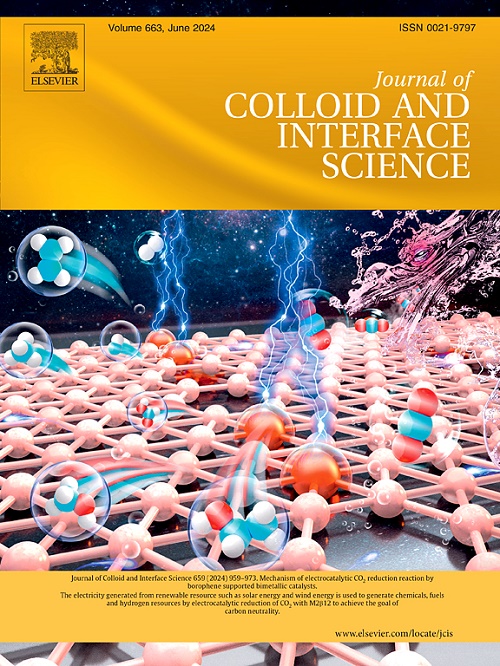间隙掺杂的 Ru 可诱导丰富的 Ni(Fe)Ru 合作位点,从而提高安培级电流密度,实现整体水分离
IF 9.4
1区 化学
Q1 CHEMISTRY, PHYSICAL
引用次数: 0
摘要
定向诱导间隙掺杂 Ru 而不是普通的取代掺杂是一项挑战。此外,DFT 计算显示,与取代型 Ru 掺杂相比,间隙型 Ru 掺杂能诱导丰富的 Ni(Fe)Ru 合作位点,从而大大加快 HER 和 OER 的反应动力学。受此启发,我们采用 "淬火掺杂 Ru-磷化 "策略构建了间隙掺杂 Ru 的 NiFeP/NF 电极。相关的物理表征证实,间隙掺杂 Ru 可促进 Ni(Fe)Ru 协同位点的电子重置,有效避免金属原子溶解,促进更多的 Ni (Fe)OOH 活性物种。正如预期的那样,Ru-NiFeP/NF||Ru-NiFeP/NF 电解槽只需要低至 1.54 V 的电压就能产生 1 A cm-2 的电流密度。总之,这项工作从调节 Ru 掺杂位置的角度出发,创新性地构建了具有安培级电流密度的磷化电极。这为优化 Ru 掺杂策略提供了新的设计思路。本文章由计算机程序翻译,如有差异,请以英文原文为准。

The interstitial Ru dopant induces abundant Ni(Fe)Ru cooperative sites to promote ampere-level current density for overall water splitting
Directionally induced interstitial Ru dopant rather than ordinary substitutional doping is a challenge. Furthermore, DFT calculations revealed that compared with the substituted Ru dopants, the interstitial Ru dopants induce abundant Ni(Fe)![]() Ru cooperative sites, greatly expediting the reaction kinetics for HER and OER. Inspired by these, the interstitial Ru-doped NiFeP/NF electrode is constructed by the ’quenching doped Ru-phosphorization’ strategy. Relevant physical characterizations confirmed that interstitial Ru dopants promote electron reset in the Ni(Fe)
Ru cooperative sites, greatly expediting the reaction kinetics for HER and OER. Inspired by these, the interstitial Ru-doped NiFeP/NF electrode is constructed by the ’quenching doped Ru-phosphorization’ strategy. Relevant physical characterizations confirmed that interstitial Ru dopants promote electron reset in the Ni(Fe)![]() Ru synergistic sites, effectively avoiding metal atom dissolution and encouraging more Ni (Fe)
Ru synergistic sites, effectively avoiding metal atom dissolution and encouraging more Ni (Fe)![]() OOH active species. As expected, the Ru-NiFeP/NF||Ru-NiFeP/NF electrolyzer only need as low as 1.54 V to yield a current density of 1 A cm−2. In summary, this work innovatively constructs the phosphide electrode with ampere-level current density from the perspective of regulating the doping position of Ru. This provides a new design idea for optimizing the Ru doping strategy.
OOH active species. As expected, the Ru-NiFeP/NF||Ru-NiFeP/NF electrolyzer only need as low as 1.54 V to yield a current density of 1 A cm−2. In summary, this work innovatively constructs the phosphide electrode with ampere-level current density from the perspective of regulating the doping position of Ru. This provides a new design idea for optimizing the Ru doping strategy.
求助全文
通过发布文献求助,成功后即可免费获取论文全文。
去求助
来源期刊
CiteScore
16.10
自引率
7.10%
发文量
2568
审稿时长
2 months
期刊介绍:
The Journal of Colloid and Interface Science publishes original research findings on the fundamental principles of colloid and interface science, as well as innovative applications in various fields. The criteria for publication include impact, quality, novelty, and originality.
Emphasis:
The journal emphasizes fundamental scientific innovation within the following categories:
A.Colloidal Materials and Nanomaterials
B.Soft Colloidal and Self-Assembly Systems
C.Adsorption, Catalysis, and Electrochemistry
D.Interfacial Processes, Capillarity, and Wetting
E.Biomaterials and Nanomedicine
F.Energy Conversion and Storage, and Environmental Technologies

 求助内容:
求助内容: 应助结果提醒方式:
应助结果提醒方式:


